
20 minute read
La Simbiosis y su Meditación Symbiosis and its Meditation
46
// Karin Astudillo y Jean Danton Laffert
Advertisement
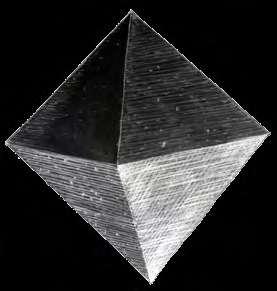
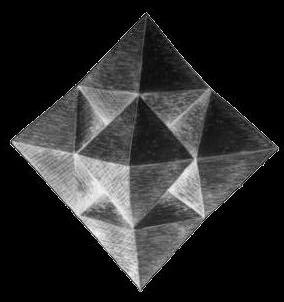
47
48
Simbiosis Meditativa es un proyecto de investigación y creación que construye una relación entre componentes materiales, biológicos y humanos. En primera instancia, realiza un cruce entre lo tecnológico y lo orgánico, entendiendo una como metáfora de la otra, para luego proponer un experimento de exhibición en base a una obra de arte que explora y visibiliza la interdependencia entre estos factores. Mas tarde, llevará a una interrelación entre investigadores de diferentes áreas, resignificando sus enfoques disciplinares.
El establecer relaciones no sólo proporciona significados, sino también conocimiento; uno sobre los elementos y su dimensión compleja. Se trata de un intrincado conocimiento de frontera, el que implica, además, una apertura a la contemplación y fascinación.
La investigación comienza a tomar forma ya en 2012, involucrando el trabajo personal del artista en el taller y los procesos de observación contemplativa y exploratoria de la naturaleza en viajes a campo abierto, con una mirada curiosa sobre la dinámica de lo vivo. Al mismo tiempo, aparece un desplazamiento hacia y desde lo humano a través de lo tecnológico, basado


Meditative Symbiosis is a research and creation project that builds a relationship between material, biological and human components. In the first instance, it makes a cross between the technological and the organic, understanding one as a metaphor for the other, for then proposing an exhibition experiment based on a work of art that explores and makes visible the interdependence between these factors. Later, it will lead to an interrelation between researchers from different disciplines, resignifying their professional approaches.
Establishing relationships not only provides meanings, but also knowledge; one about the elements and their complex dimension. It is an intricate frontier knowledge, which also implies an openness to contemplation and fascination.
The research began to take shape already in 2012, involving the artist’s personal work in the workshop and the processes of contemplative and exploratory observation of nature on trips to the open field, with a curious look at the dynamics of the living. At the same time, there is a movement towards and from the human through the technological, based on a series 49
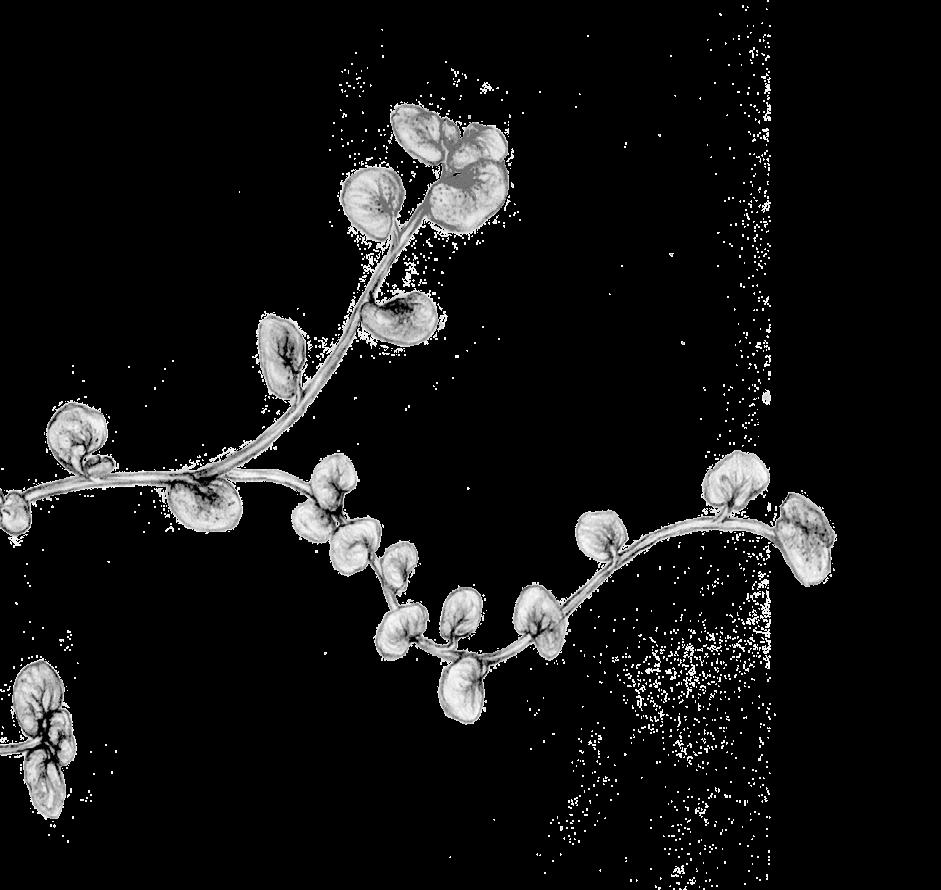
en una serie de trabajos previos con medios digitales y electrónicos. En esta convergencia se tensionan los materiales y sus significados, emergiendo Simbiosis Meditativa como objeto artístico y exponiéndose en dos instancias: Galería Patio Bellavista en 2017 y MAC de Valdivia en 2018.
Desde sus orígenes la obra define una ruta, en su propia plasticidad hacia una exploración en lo científico. El artista, creador-investigador, trabaja entonces no solo desde lo natural, sino que también desde lo biológico. La interacción con la ciencia se da en la experimentación, a través de ciertos fenómenos medibles y técnicamente manipulables, levantando desde aquí un sentido expresivo.
50
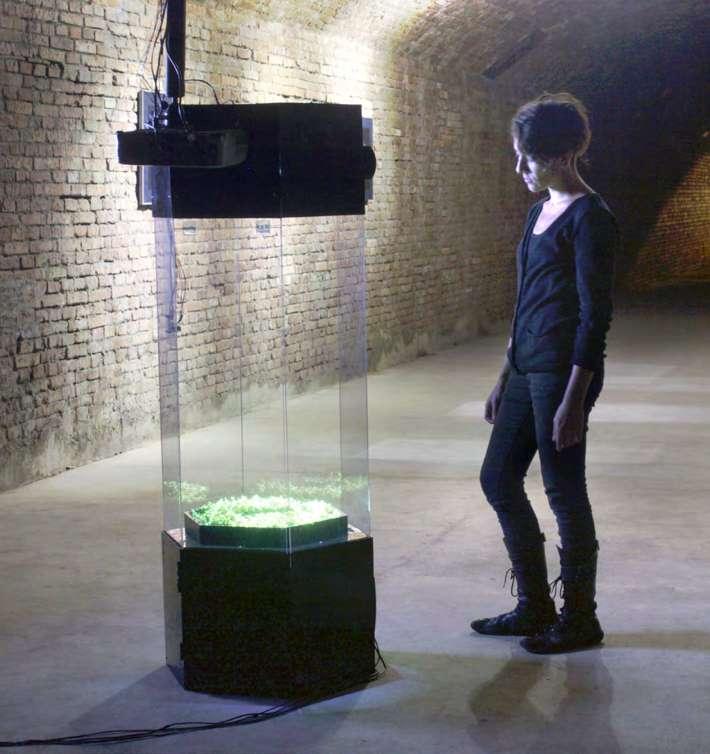
of previous works with digital and electronic media. In this convergence, the materials and their meanings are stressed, emerging Meditative Symbiosis as an artistic object and exhibiting in two instances: Patio Bellavista Gallery in 2017 and MAC of Valdivia in 2018.
From its origins the work defines a route, in its own plasticity, towards an exploration in science. The artist, creator-researcher, then works not only from the natural, but also from the biological. The interaction with science occurs in experimentation, through certain measurable and technically manipulable phenomena, raising from here an expressive sense.

51
52
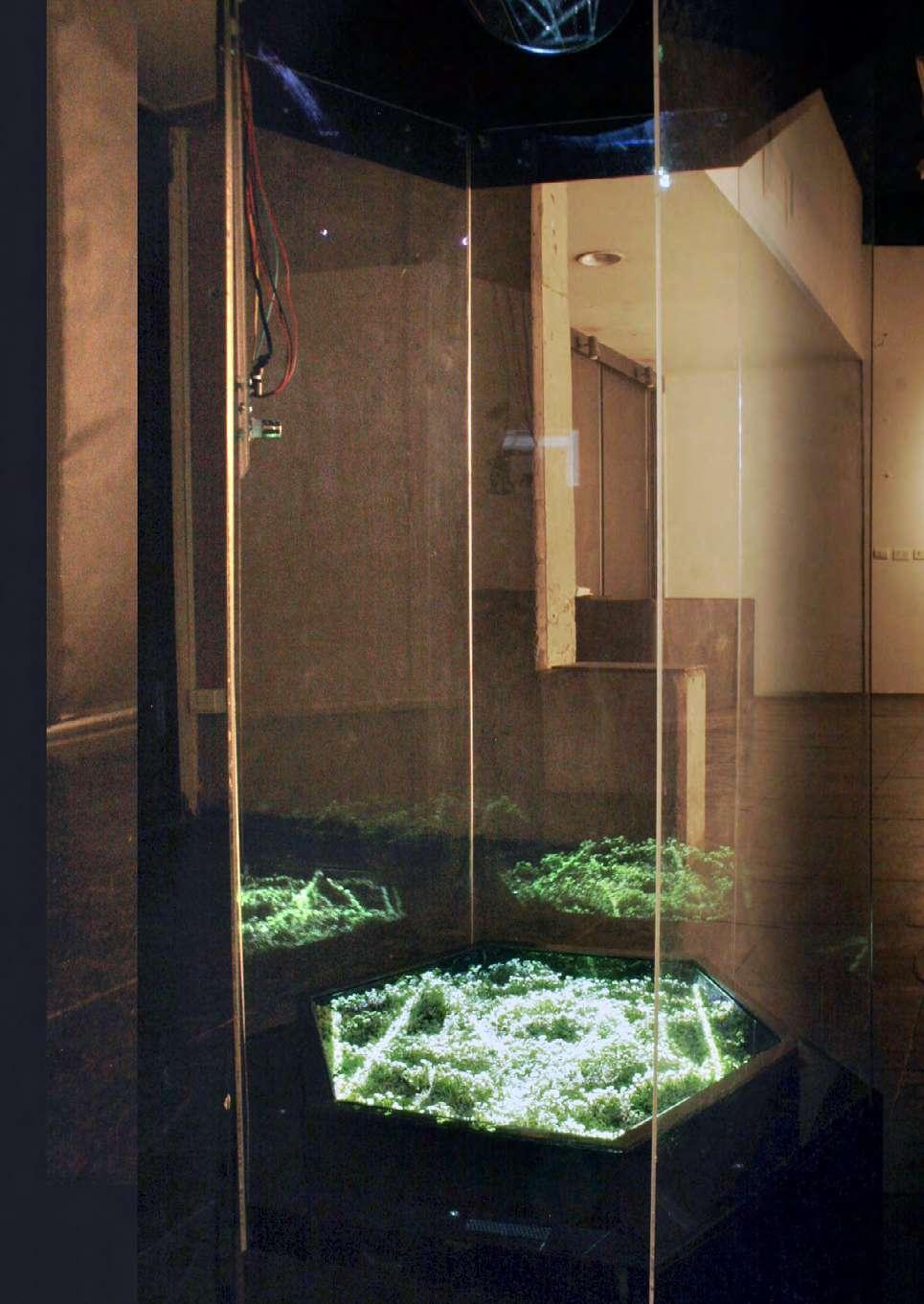
53
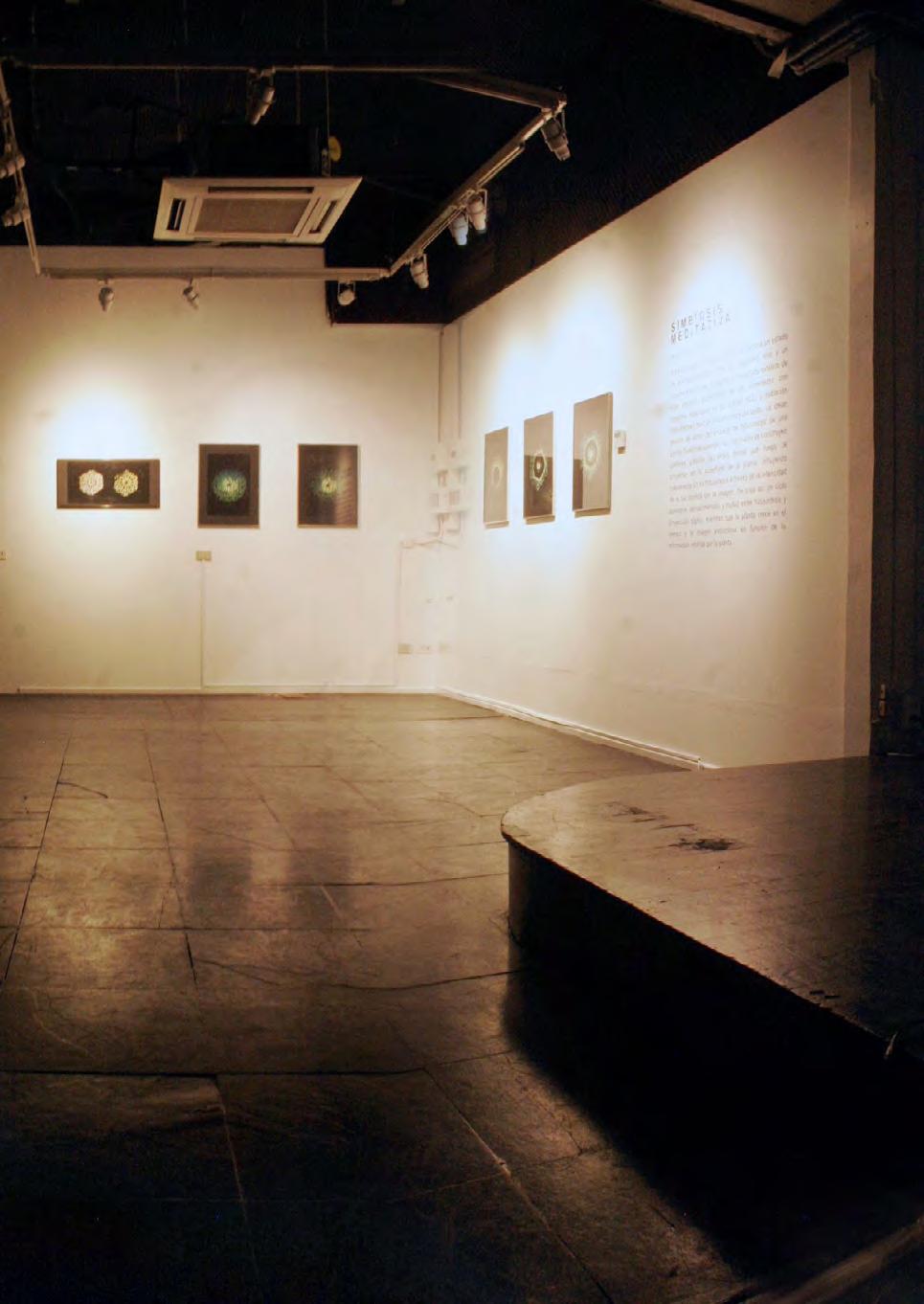
54
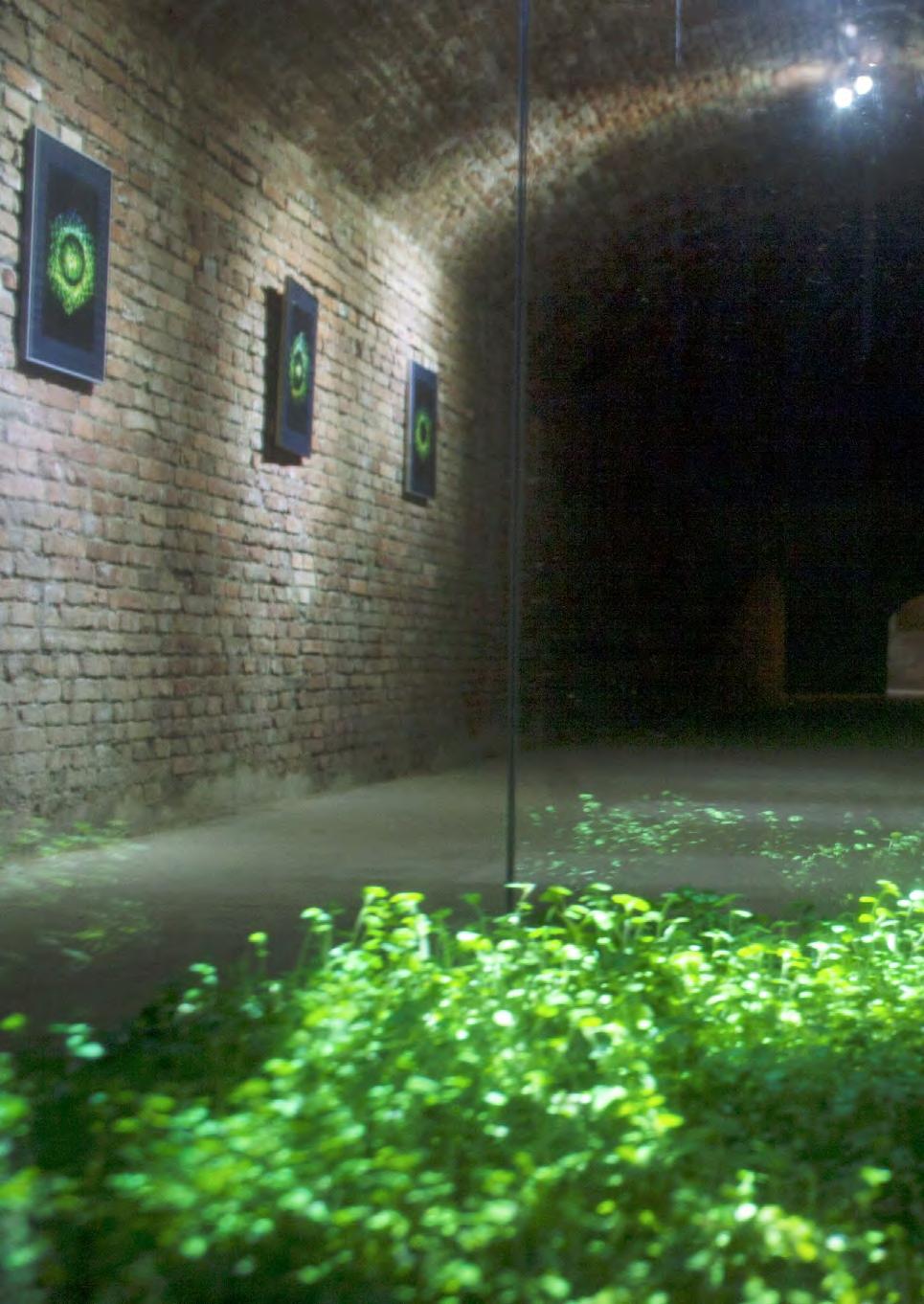
55
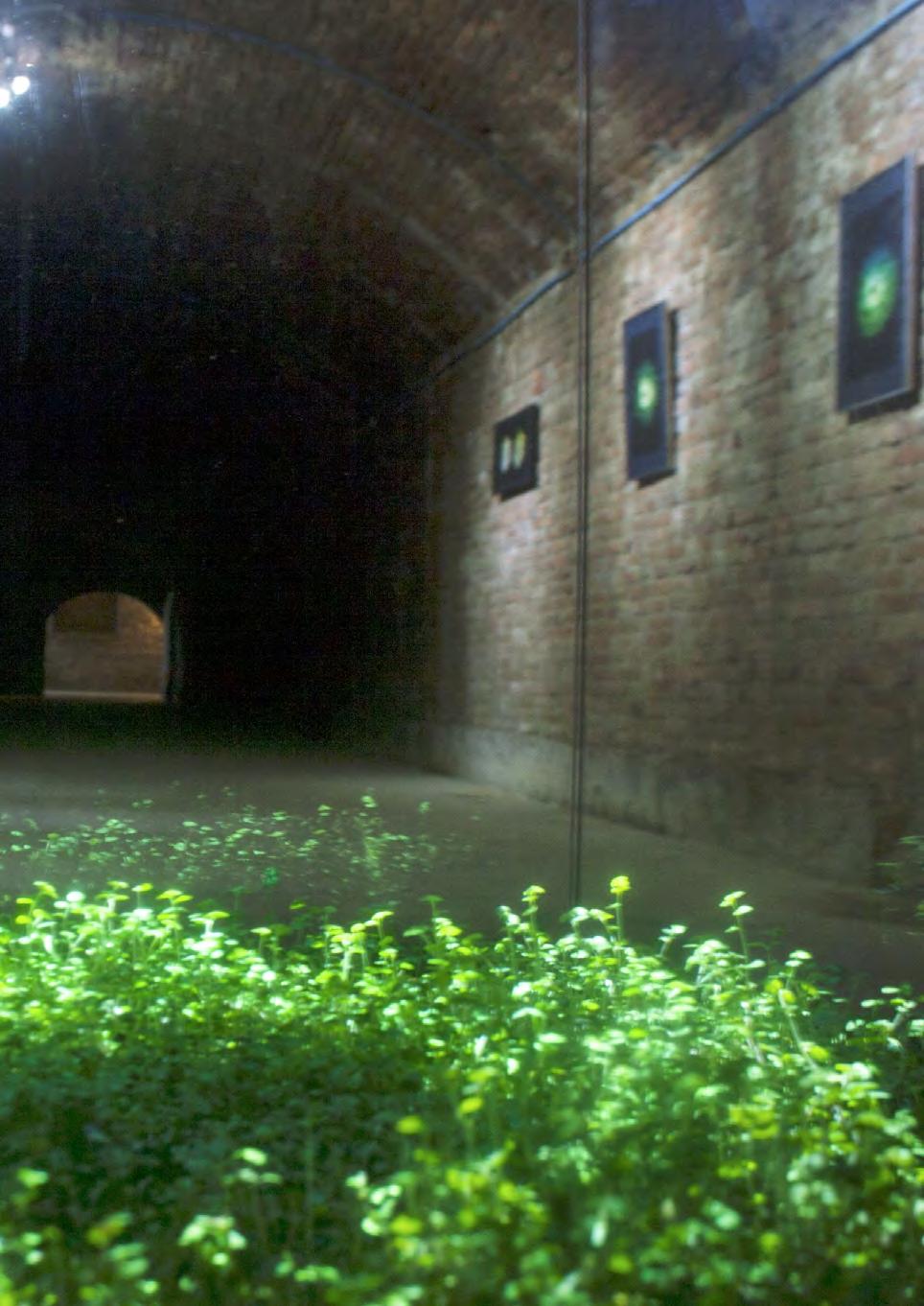
56
La puesta en relación entre el arte y la ciencia, inicialmente polarizada en la forma de extremos, se modifica con la participación de la filosofía. En 2018 dimos inicio a una dinámica de trabajo en común, desafiando nuestros lugares de formación inicial a través del enfoque interdisciplinario. Así, desarrollamos una investigación entre Arte y Filosofía en torno a la pregunta por lo abstracto en el contexto escolar, trabajando directamente con niños y niñas de quinto básico, derivando en un método de aproximación a los mismos temas (contenidos) que mas tarde tuvo una gran recepción en espacios académicos. Lo que vendrá más adelante es la expansión y de este modelo, a través de lo que ya ofrecía Simbiosis Meditativa, primero como obra de arte por sí misma, y ahora como plataforma conectiva para otras dimensiones de la investigación artística.
Si en el principio de Simbiosis Meditativa el arte y la ciencia parecían mostrar la condición interna y externa de los modos y medios en juego, con la entrada de la filosofía estas dos posiciones se modifican. El arte y la ciencia se nos muestran respectivamente ahora en cuanto condición intermedia y externa (González Valerio, 2014). El modo del arte será la indeterminación mediante el uso de la materia y el lenguaje; el de la ciencia, la comprobación de lo enunciado en sus hipótesis, a través del estudio de lo vivo y la materia; pero el modo de la filosofía revela ahora la verdadera condición interna de esta nueva relación, que tensiona su primera forma mediante la implicación del pensamiento y la acción, la síntesis entre la experiencia y el cuerpo, trayendo y generando nuevos significados, el cuerpo en cuanto productor genuino de lenguaje e hipótesis, en cuanto poseedor de la vitalidad y materialidad advertida a través de sí mismo.
En el juego de la experimentación conjunta o triada de saberes, el arte y la filosofía revelan sus distancias con los modos de experimentación de la ciencia, pero también sus cercanías posibles al poner el arte en el medio. Un juego donde el arte queda tensionado al modo de un núcleo de relaciones infinitas entre saberes, modos y medios de las distintas disciplinas.
En este sentido, el año 2019 se pone en marcha la aplicación de esta relación de saberes, respaldados por un proyecto FONDART, con el cual pudimos convocar a un nuevo integrante: Camilo Gouet (biólogo), con lo que no sólo asentábamos un ánimo de perfeccionamiento, sino de construir evidencias sobre el ideal de investigación transdisciplinar. Todo mediante la plataforma del arte o la relación de modos y métodos distintos sobre la misma obra.
Pero la existencia de un fin común no nubló la posibilidad de fines personales y diversos. Si bien todos apuntábamos a la materialización de una investigación transdisciplinar para ser mostrada en el MAC, cada uno de
The relationship between art and science, initially polarized in the form of extremes, is modified with the participation of philosophy. In 2018 we started a common work dynamic, challenging our initial training places through the interdisciplinary approach. Thus, we developed an investigation between Art and Philosophy around the question of the abstract in the school context, working directly with boys and girls of fifth grade, deriving in an approaching method of the same topics (contents) that later had a great reception in academic spaces. What will come later is the expansion of this model, through what Meditative Symbiosis already offered, first as a work of art in its own right, and now as a connecting platform for other dimensions of artistic research.
If at the beginning of Meditative Symbiosis art and science seemed to show the internal and external condition of the modes and means at work, with the entry of philosophy these two positions are modified. Art and science are now shown to us respectively as intermediate and external condition (González Valerio, 2014). The art mode will be indetermination through the use of matter and language; that of science, the verification of what is stated in their hypotheses, through the study of the living and matter; but the mode of philosophy now reveals the true internal condition of this new relationship, which stresses its first form through the involvement of thought and action, the synthesis between experience and the body, bringing and generating new meanings, the body as genuine producer of language and hypothesis, as possessor of the vitality and materiality announced through himself.
In the game of joint experimentation or triad of knowledge, art and philosophy reveal their distances with the modes of experimentation of science, but also their possible proximity by putting art in the middle. A game where art is stressed in the manner of a nucleus of infinite relationships between knowledge, modes and means of the different disciplines.
In this sense, in 2019 the application of this relationship of knowledge began, supported by a FONDART project, with which we were able to summon a new member: Camilo Gouet (biologist), with which we not only established a spirit of improvement, but to build evidence on the ideal of transdisciplinary research. All through the art platform or the relationship of different modes and methods on the same work. 57
58
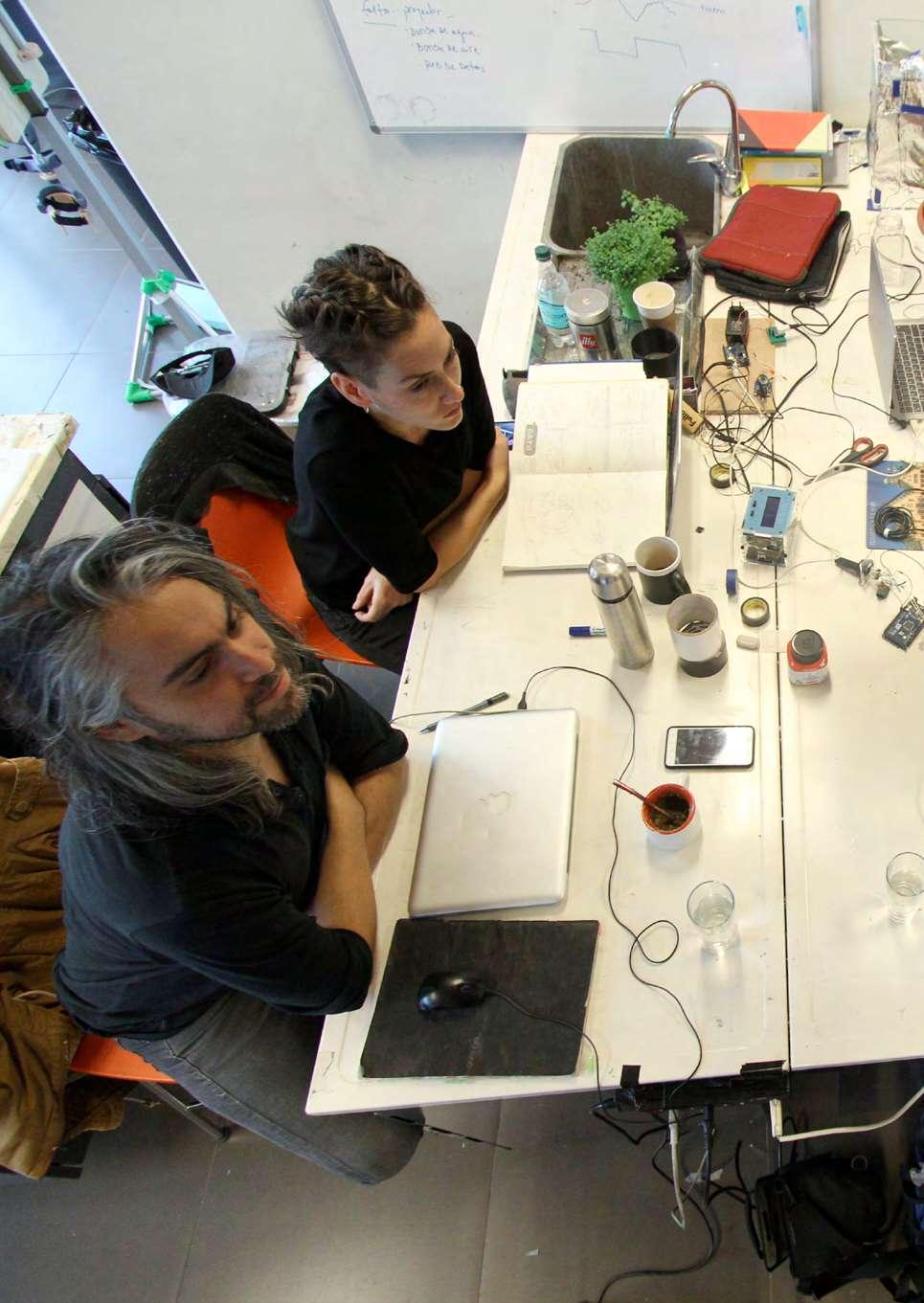
59
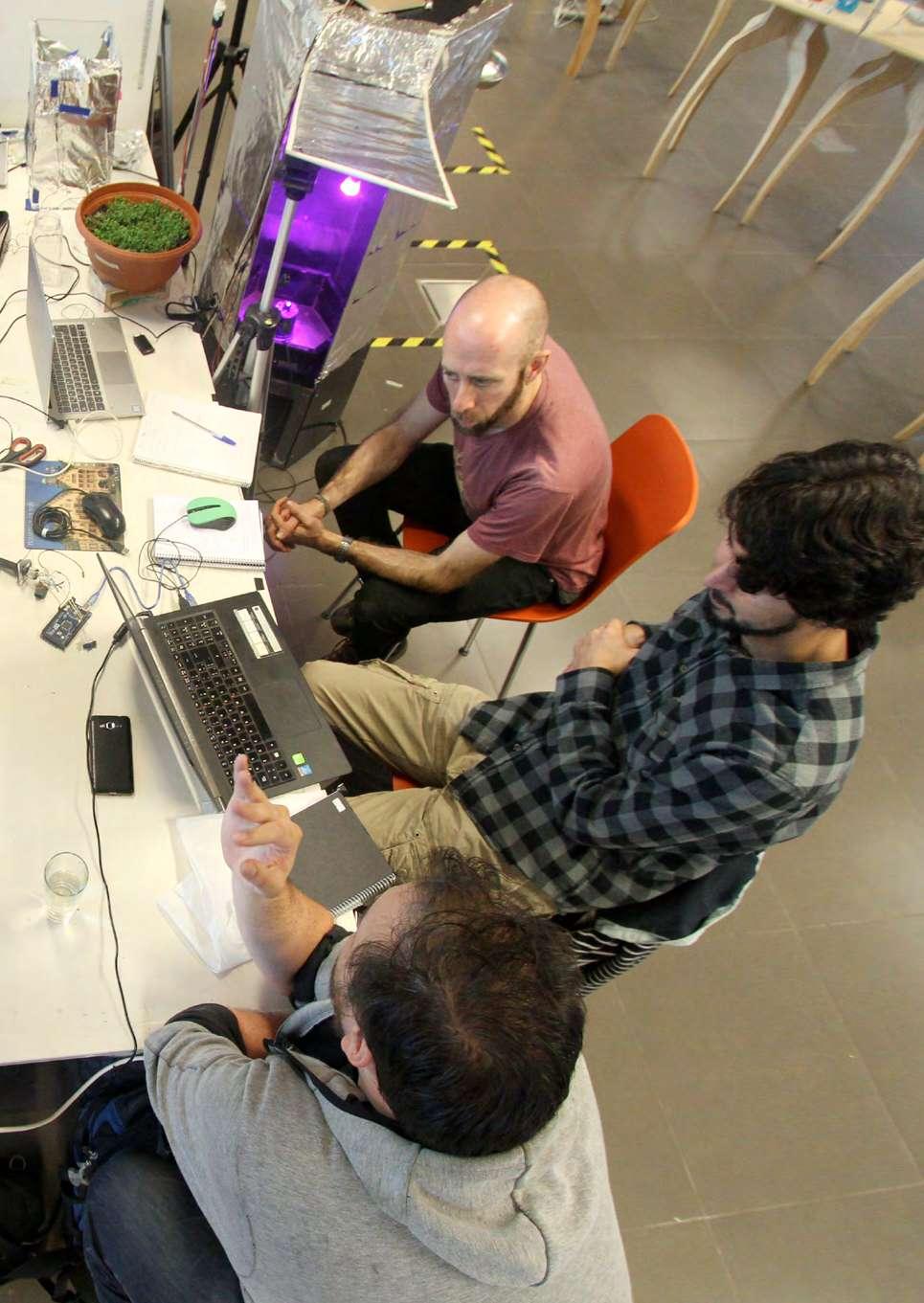
“La interdisciplinariedad no es una entidad abstracta que pueda explicarse en términos genéricos, sino que cobra significado en la misma práctica artística, así como en la negociación que se produce entre los artistas y los científicos, entre los mismos artistas y entre todos ellos y los teóricos”
“Interdisciplinarity is not an abstract entity that can be explained in generic terms, but it takes on meaning in the artistic practice itself, as well as in the negotiation that takes place between artists and scientists, between the artists themselves and between all of them and the theorists“
López del Rincón (2003)
60 nosotros pudo establecer objetivos particulares que se deslizaban sobre las cualidades de cada una de nuestras disciplinas. Tarea que nos fomentábamos a encontrar/inventar en Simbiosis Meditativa.
El FabLab de la U. de Chile acogió nuestra propuesta, un lugar que no sólo nos brindaba un espacio, sino también la colaboración de una comunidad de personas con proyectos y conocimientos heterogéneos. En este contexto, se incorporan Esteban Norambuena para las interfaces electrónicas, Mauricio Hormazábal en el área de informática y el equipo de dirección y operación del Fablab. Esta será una conjunción de modos y medios que fortalecerán el diseño, el sistema y el modelo original de la obra.
Pero se podría pensar que al igual que en una investigación tradicional, el objetivo general determina y subordina los objetivos específicos. Sin embargo, la condición de apertura de la investigación transdisciplinar favorece la permeabilidad entre ellos. Un ejemplo de esto es el momento en el cual, en cierta instancia del proceso de investigación, se presenta un dilema para el científico y el artista: los datos de dióxido de carbono sensados en los experimentos previos no proyectaban pruebas consistentes de los cambios de este gas por la fotosíntesis de la planta dentro del contenedor de la obra; y por ende, un proyecto científicamente insuficiente como para generar un protocolo. Luego de unos meses de progreso pensamos que habría que cambiar radicalmente la estructura de Simbiosis Meditativa o simplemente, que no tendría expectativas de funcionar pues los gráficos no mostraban cambios evidentes para Camilo. La pregunta final fue: ¿Pero de que tipo de cambios evidentes estamos hablando? Así, al re-observar juntos los gráficos y en diálogo recíproco, nos dimos cuenta que el gráfico variaba sutilmente pero con un valor importante en su progresión en el tiempo. Su velocidad era afectada por la presencia de la planta en reacción fotosintética a la luz del proyector. Esto requería de un enfoque distinto respecto a lo esperado por los papers que habían servido de referencia. El protocolo de investigación que acompaña a la obra da cuenta de la validez de este cambio de perspectiva. Esta mixtura de objetivos demuestra que el factor plástico no sólo afecta la obra sino que a la investigación misma.
El 27 de Junio fue la inauguración de Simbiosis Meditativa en el Museo de Arte Contemporáneo de Parque Forestal. Esta exposición no significó un término del proceso de investigación en laboratorio, sino mas bien su
But the existence of a common goal did not cloud the possibility of personal and diverse ends. Although we all aimed at the materialization of a transdisciplinary research to be shown at the MAC, each of us was able to establish particular objectives that glided over the qualities of each of our disciplines. Task that we encouraged ourselves to find / invent in Meditative Symbiosis.
The FabLab of the U. de Chile welcomed our proposal, a place that not only offered us a space, but also the collaboration of a community of people with heterogeneous projects and knowledge. In this context, Esteban Norambuena for the electronic interfaces, Mauricio Hormazábal in the IT area and the management and operation team of Fablab join. This will be a conjunction of ways and means that will strengthen the design, the system, and the original model of the work.
But one might think that, as in traditional research, the general objective determines and subordinates the specific objectives. However, the openness of transdisciplinary research favors permeability between them. An example of this is the moment in which, at a certain point in the research process, a dilemma presents itself for the scientist and the artist: the carbon dioxide data sensed in previous experiments did not project consistent evidence of changes in this gas from photosynthesis of the plant inside the work container; and therefore, a scientifically insufficient project to generate a protocol. After a few months of progress, we thought that the structure of Meditative Symbiosis would have to be radically changed, or simply that it would not have any expectations of working because the graphics did not show obvious changes for Camilo. The final question was: But what kinds of obvious changes are we talking about? Thus, when re-observing the graphs together and in reciprocal dialogue, we realized that the graph varied subtly but with an important value in its progression over time. Its speed was affected by the presence of the plant in photosynthetic reaction to the light from the projector. This required a different approach from what was expected by the papers that had served as a reference. The research protocol that accompanies the work shows the validity of this change in perspective. This mixture of objectives shows that the plastic factor not only affects the work but also the research itself.
On June 27 was the inauguration of Meditative Symbiosis at the Museum of Contemporary Art in Parque Forestal. This exhibition did not mean an end to the laboratory research process, but rather its extension, by spec61
Secuencia de crecimiento adaptativo entre planta y patrón lumínico a través del tiempo
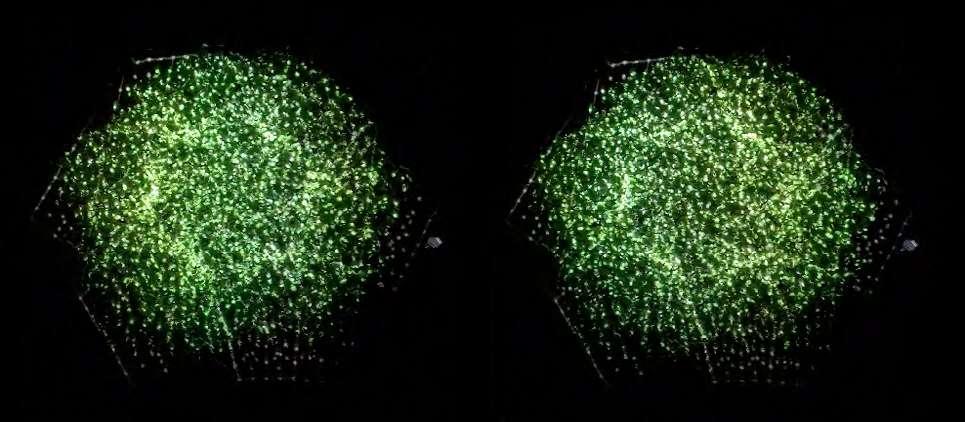
62

Adaptative growing secuence of the plant and the ligth patterns, a long time

63
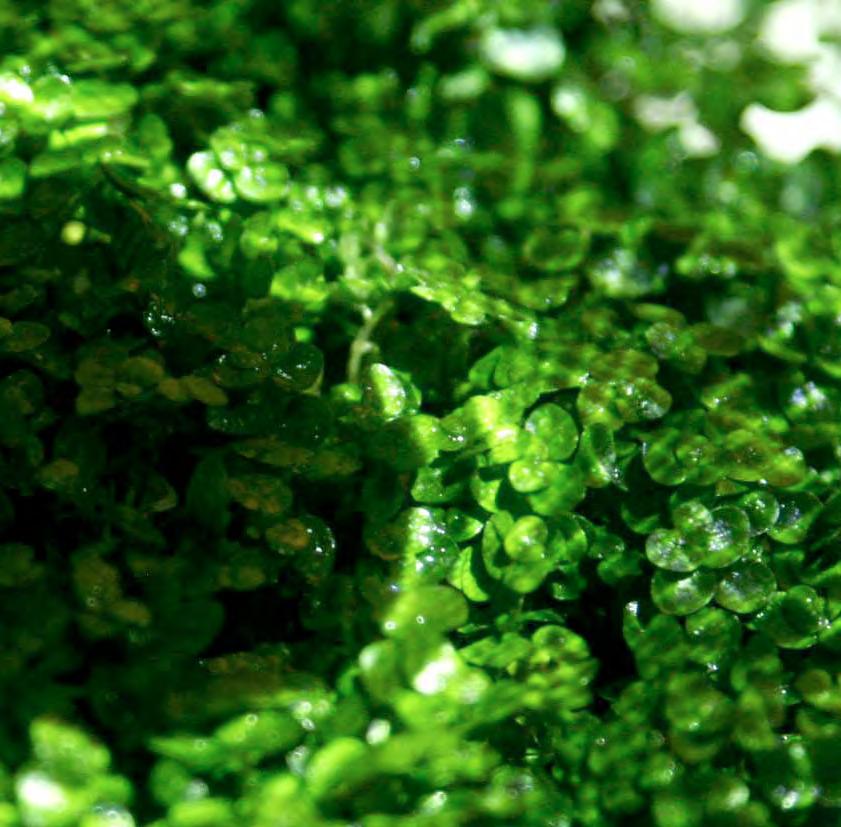

64

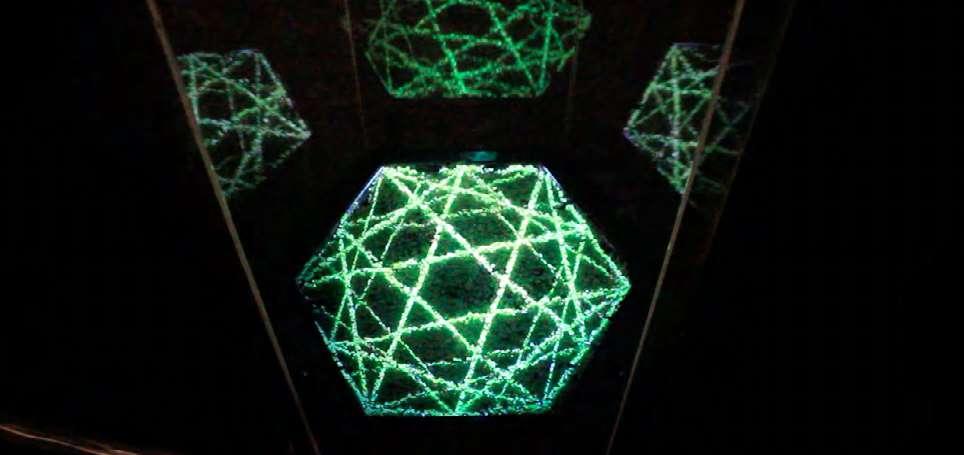

65
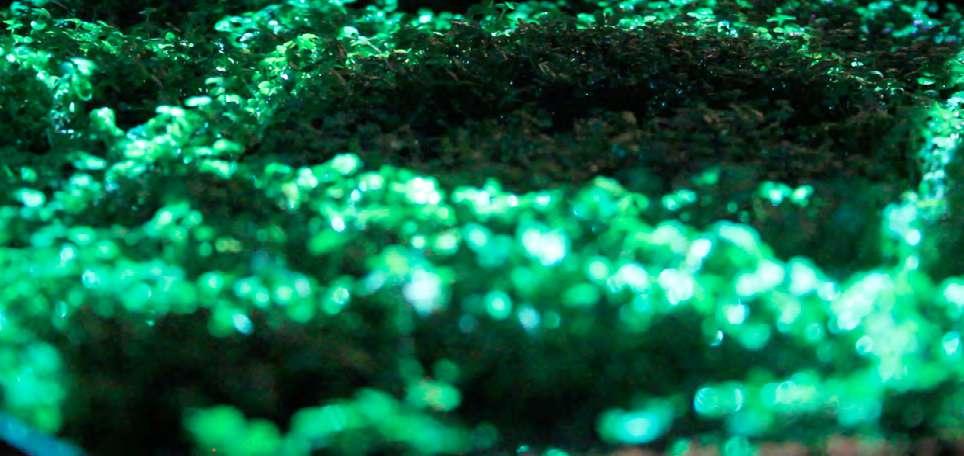

66 extensión, al concretar la condición evolutiva de la obra: cada una de sus próximas exhibiciones demarcó un estado de avance, ya que la reacción fotosintética de las plantas continuó siendo medida –esta vez en cuatro contenedores– bajo las condiciones particulares que la sala de arte del MAC disponía. Estos datos permitieron estudiar continuamente el crecimiento, las variaciones en cada contenedor de acuerdo al tipo de luz, patrones de fractalización, comportamiento de la tierra y estabilidad del sistema en cada caso. En cierto sentido, se podría decir que este sistema electrónico-orgánico se consagró como un “nuevo integrante” al definir la ruta y las posibilidades de su propio estudio mientras se encontraba exhibido. Entendido así, fue inevitable la hibridación entre el laboratorio y la sala de arte. Esta condición devino en la idea de crear instancias de apertura de la obra, donde el espectador pudo vivirla en su faceta de estudio; dando origen a los “Laboratorios abiertos”, como una nueva circunstancia en la exposición.
Los laboratorios abiertos se desarrollaron en tres sesiones. Al mismo tiempo que se estudiaba el estado de los sistemas y la situación de las plantas, se hacían intervenciones en relación a los mejoramientos realizados paralelamente en el la-

ifying the evolutionary condition of the work: each of its next exhibitions demarcated a state of progress, since the photosynthetic reaction of plants continued to be measured –this time in four containers– under the particular conditions that the MAC art room had. These data made it possible to continuously study the growth, the variations in each container according to the type of light, fractalization patterns, behavior of the earth and stability of the system in each case. In a sense, it could be said that this electronic-organic system established itself as a “new member” by defining the route and possibilities of its own study while it was exhibited. Understood in this way, the hybridization between the laboratory and the art room was inevitable. This condition resulted in the idea of creating opening instances of the work, where the viewer could experience it in his facet of study; giving rise to the “Open Laboratories”, as a new circumstance in the exhibition.
The open laboratories were developed in three sessions. At the same time that the state of the systems and the situation of the plants were studied, interventions were made in relation to the improvements carried out in parallel in the Fablab laboratory, which involved opening containers in the
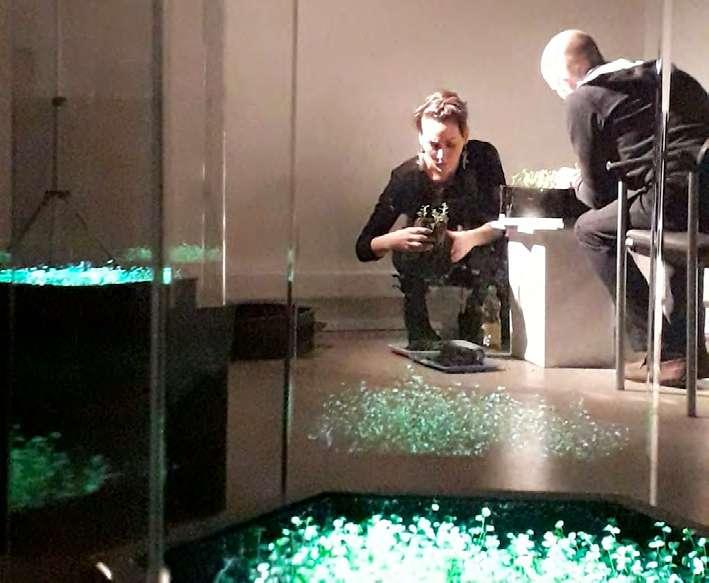
67
68 boratorio Fablab, lo que involucraba abrir contenedores en presencia de las y los espectadores, realizar conversatorios entre asistentes y el equipo de investigación, abarcando las distintas disciplinas y técnicas. El hecho de que la obra haya sido trabajada en el Fablab, nos puso el particular desafío de abrir el conocimiento que de ella se extraía en instancias vinculadas a la comunidad. Un ejemplo de esto es la experiencia de la filosofía, donde se disponía el diálogo filosófico espontáneo como herramienta de indagación para la obra, a través del análisis de sus conceptos, fundamentos y perspectivas. Con esto, además de romper con la idea de que el conocimiento es exclusivo de quien lo posee, se dispuso la reflexión desde un formato cotidiano y en espacios no convencionales. Al mismo tiempo que sintonizábamos con una praxis de apertura inspirada en el concepto de Open-source.
Esta puesta en relación del arte, el conocimiento y la sociedad, tomaron un segundo impulso en la siguiente exhibición de este trabajo en el Ars Electronica Festival 2019 en Linz, Austria; que en su versión nº 40 conmemoraba la consigna que le dio su sentido y su mismo origen: la tríada arte-tecnología-sociedad. Al mismo tiempo el proyecto asentó un nuevo estado de avance en su diseño, perfeccionando su sistema, la composición de sus materiales y capturando nuevos datos de fotosíntesis. Esto nos reforzó la sensación de que la obra mostraba crecimiento, evolucionaba, ganaba experiencia a medida que encontraba instancias expositivas como esta y las venideras: Galería Cava Palacio Cousiño en Santiago de Chile y Galería Atelier Güell en Barcelona, España. Cada una de estas plataformas fue asimismo un desafío para nosotros, en el ir constantemente replanteando las formas de trabajo, posibilidades y resultados, desde la obra y nuestro ejercicio colaborativo.
Toda esta experiencia de la transdisciplinariedad en el contexto del arte, nos habla de la necesidad de flexibilidad de los métodos y los modos de cada una de las disciplinas que se reúnen con este fin. Es un constante desafío frente a la tentación de rigidez que sobreviene al sentimiento de experticia, se hace imperativa la consideración de un nuevo enfoque que sitúe al investigador desde la devoción por su propia disciplina; haciéndose un creador sumergido en la práctica, en sus conocimientos y en su intuición, al modo de un artesano que mantiene una ineludible relación con el quehacer de su trabajo. Solo desde esta primera relación genuina, la transdisciplinariedad será un proyecto posible, donde autenticidad signifique muchas veces transgredir o transformar aquello que se ejerce.
presence of the spectators, conducting conversations between attendees and the research team, covering the different disciplines and techniques. The fact that the work has been worked on at Fablab, gave us the particular challenge of opening the knowledge that was extracted from it in instances linked to the community. An example of this is the experience of philosophy, where spontaneous philosophical dialogue was used as an inquiry tool for the work, through the analysis of its concepts, foundations and perspectives. With this, in addition to breaking with the idea that knowledge is exclusive to those who possess it, reflection was arranged from an everyday format and in unconventional spaces. At the same time, we were in tune with an openness practice inspired by the concept of Open-source.
This relationship between art, knowledge and society, took a second impulse in the next exhibition of this work at the Ars Electronica Festival 2019 in Linz, Austria; that in its version No. 40 it commemorated the slogan that gave it its meaning and its very origin: the art-technology-society triad. At the same time, the project established a new state of advance in its design, perfecting its system, the composition of its materials and capturing new photosynthesis data. This reinforced for us the feeling that the work was growing, evolving, gaining experience as it encountered exhibitions like this and those to come: Galería Cava Palacio Cousiño in Santiago de Chile and Galería Atelier Güell in Barcelona, Spain. Each of these platforms was also a challenge for us, in constantly rethinking the ways of working, possibilities and results, from the work and our collaborative exercise.
All this experience of transdisciplinarity in the context of art, speaks to us of the need for flexibility in the methods and modes of each of the disciplines that come together for this purpose. It is a constant challenge in the face of the temptation of rigidity that comes from the feeling of expertise, it is imperative to consider a new approach that places the researcher from the devotion to his own discipline; becoming a creator immersed in practice, in his knowledge and in his intuition, in the manner of a craftsman who maintains an inescapable relationship with the task of his work. Only from this first genuine relationship, trans disciplinarity will be a possible project, where authenticity often means transgressing or transforming what is exercised. 69
70

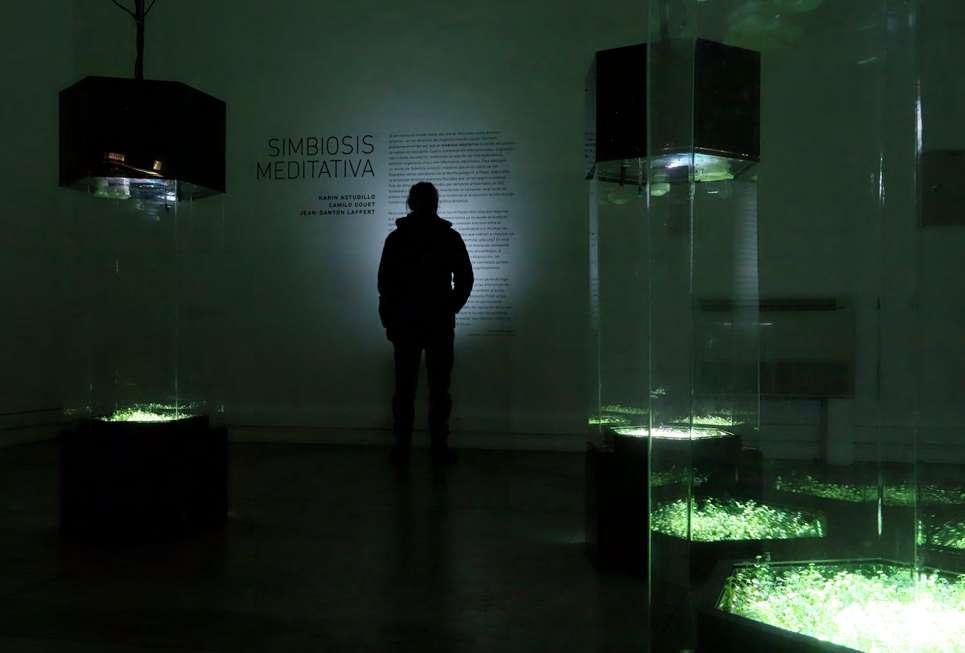
71
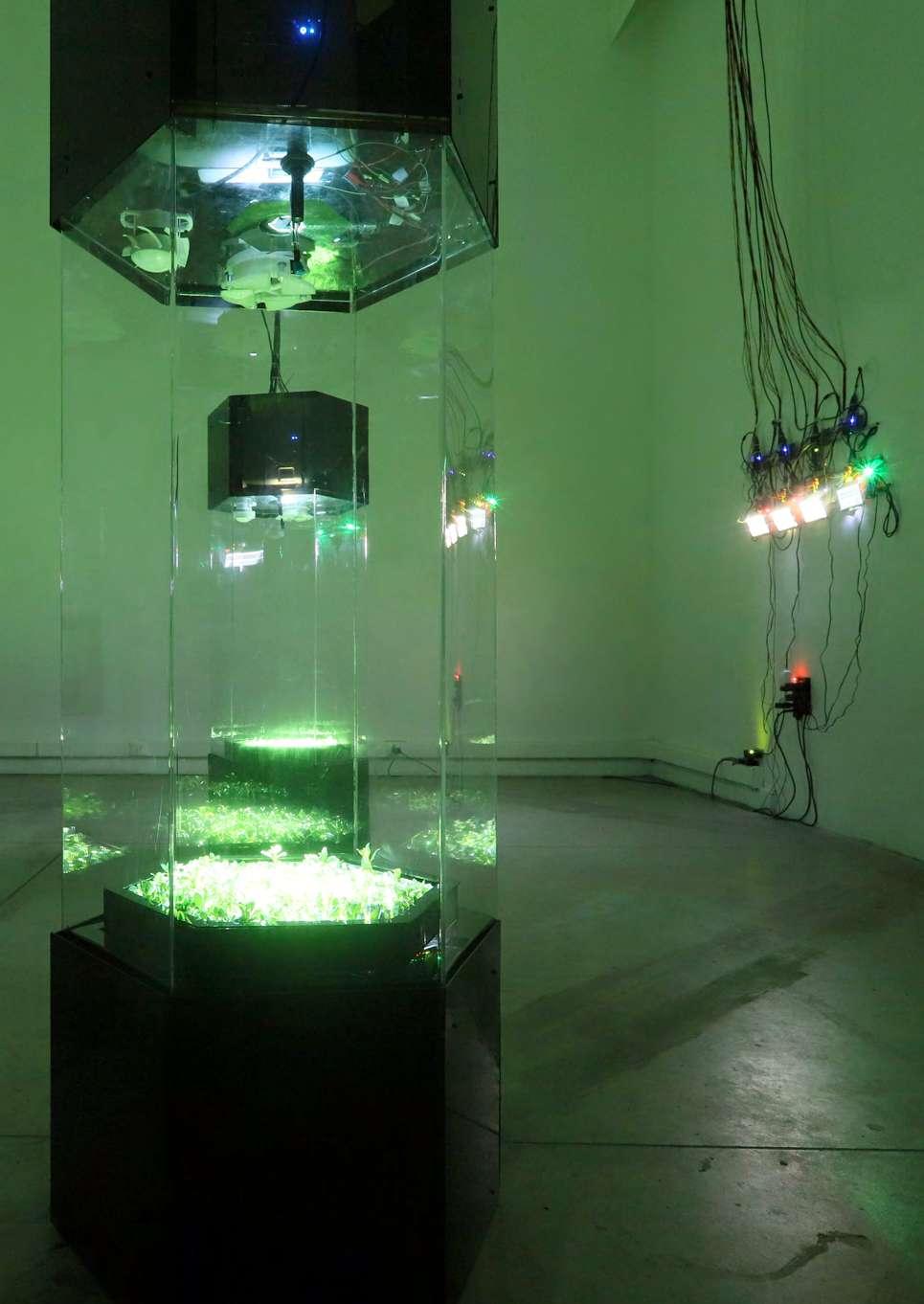
Simbiosis Meditativa en Museo de Arte Contemporáneo de Santiago, 2018 Simbiosis Meditativa at the Contemporary Art Museum, Santiago, 2018.
72

Simbiosis Meditativa en Festival Ars Electrónica, Linz, Austria, 2018 Simbiosis Meditativa at Ars Electronica Festival, Linz, Austria, 2018.
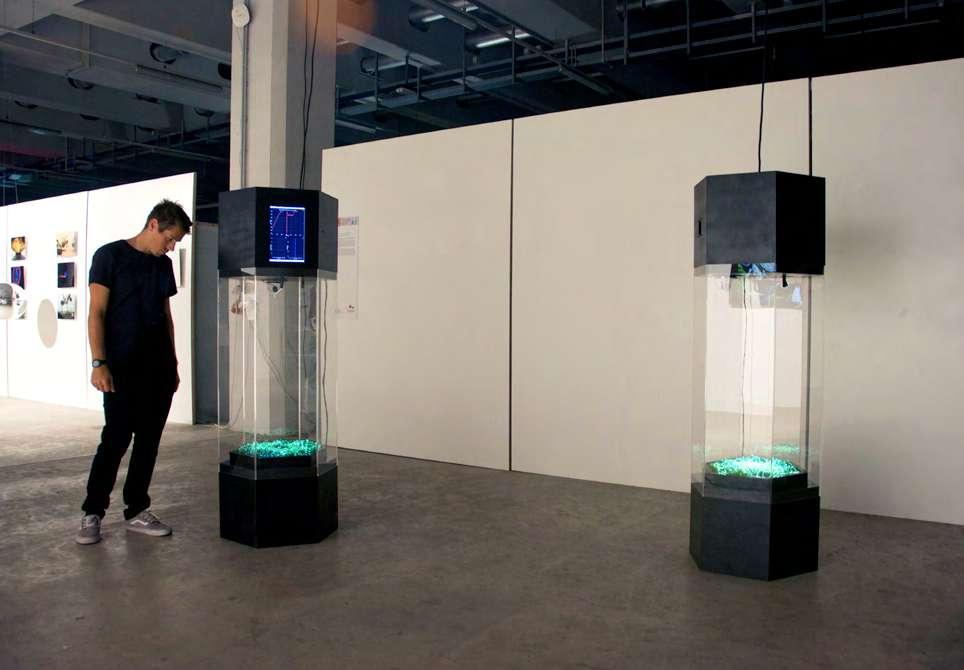
73
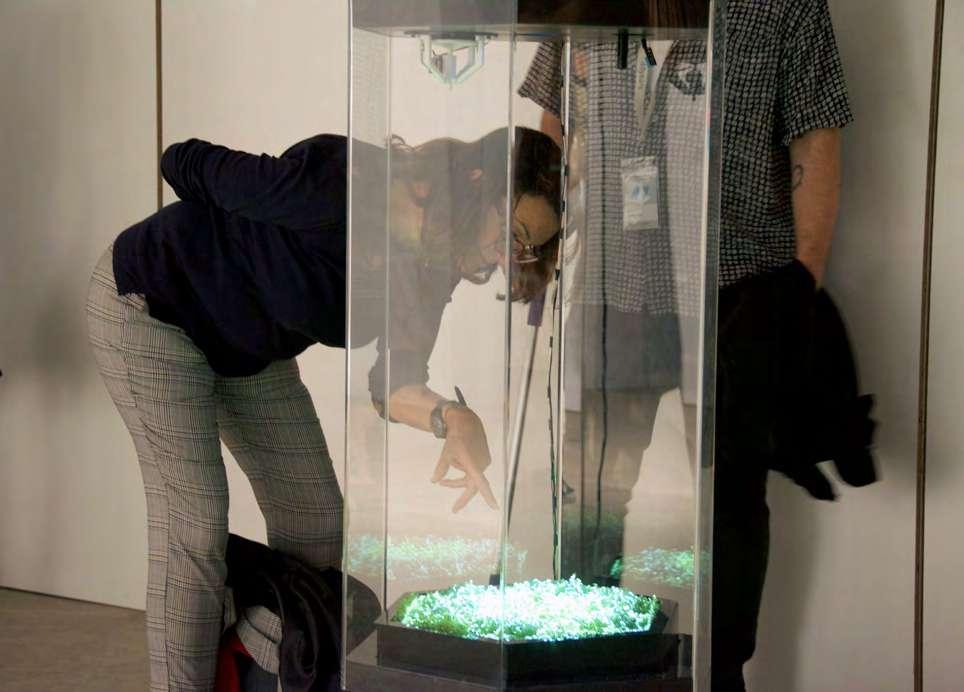
76


77




